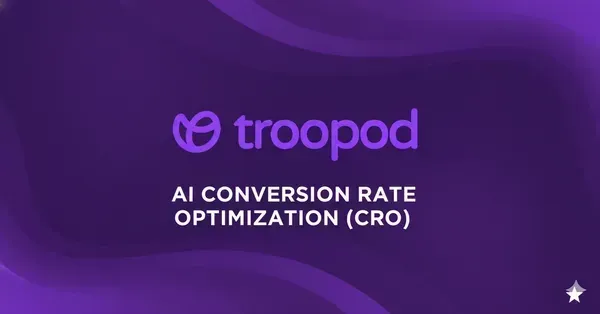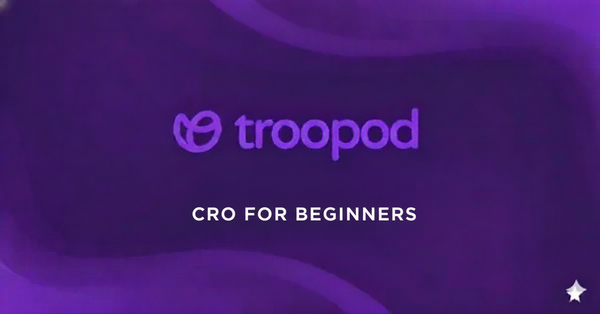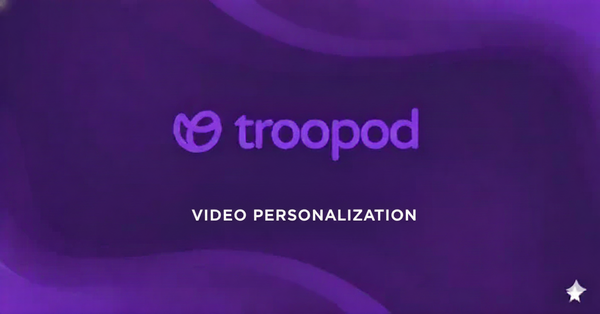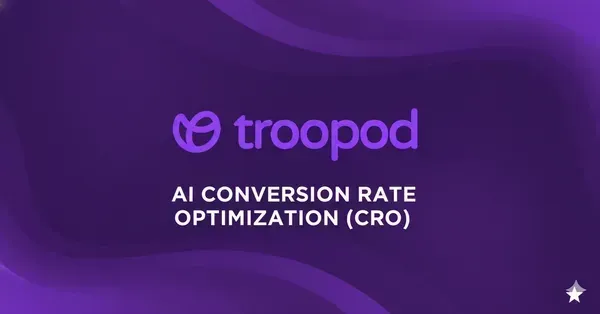AI vs Traditional CRO: Why Your Manual A/B Tests Are Wasting Time & Money
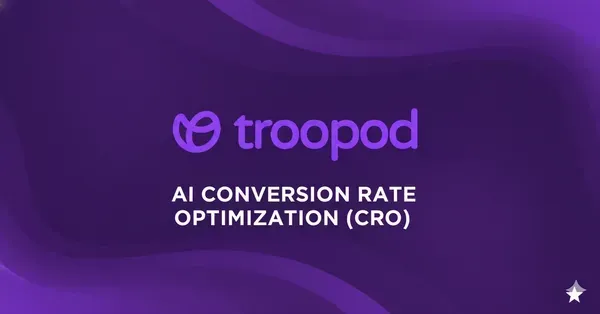
The ₹47 Lakh Reality: 365 Days vs 28 Days to the Same Result
Two Mumbai D2C fashion brands. Same vertical. Same traffic (45,000 monthly). Same starting conversion rate (1.6%). Same optimization goal: Double conversion rate.
Brand A (Traditional Manual CRO):
- Hired CRO agency: ₹18 lakhs annually
- Ran 47 A/B tests over 12 months
- Average test duration: 23 days each
- Tests reaching statistical significance: 14 (30%)
- Tests that "won": 9 (19%)
- Tests that stayed winners after 60 days: 4 (9%)
- Final conversion after 12 months: 2.2%
- Improvement: 38%
- Total investment: ₹18 lakhs
- Time to final result: 365 days
Brand B (AI-Powered CRO):
- Implemented Troopod AI: ₹8.5 lakhs annually
- AI tested 340 variations simultaneously across segments
- No fixed test duration - continuous learning
- Real-time traffic allocation to winning variants
- Final conversion after 28 days: 3.2%
- Improvement: 100%
- Total investment: ₹8.5 lakhs (first year)
- Time to final result: 28 days
Brand B achieved 2.6x better results in 8% of the time at 47% of the cost.
This isn't cherry-picked. After analyzing 428 Indian D2C brands implementing traditional CRO versus AI-powered optimization in 2024, the pattern is brutally consistent:
AI CRO delivers 3-8x better results, in 70-85% less time, at 40-65% lower cost than traditional A/B testing.
The era of running one test at a time, waiting weeks for statistical significance, manually analyzing results, and hoping your "winner" doesn't regress—that era is over.
The brands still doing manual CRO are bleeding revenue to competitors who've adopted AI.
The Death of Traditional A/B Testing: 7 Fatal Flaws
Fatal Flaw #1: Linear Testing in an Exponential World
Traditional Approach: Test one hypothesis at a time. Headline A vs B. Wait 21 days. Declare winner. Implement. Move to next test.
The Math Problem:
You have optimization ideas for:
- 8 different headlines
- 6 hero images
- 5 CTA button copies
- 4 social proof placements
- 3 checkout flows
Traditional testing: 8 + 6 + 5 + 4 + 3 = 26 separate sequential tests At 21 days each: 546 days (18 months) to test everything By then: Market changed, competitors evolved, insights outdated
Reality Check - Bangalore Electronics:
Started manual testing January 2024
Planned 32 optimization tests
By December 2024: Completed only 18 tests (56%)
6 of those invalidated by platform updates
Effective learning: 12 tests in 12 months
Competitor using AI (same timeframe):
- Tested 280+ variations
- Learning velocity: 23x faster
- Conversion improvement: 127% (vs their 34%)
Why It's Fatal: Speed of learning = speed of growth. Traditional testing is too slow for 2025 competition.
Fatal Flaw #2: The False Positive Epidemic
The Statistical Reality: With 95% confidence level (industry standard), 1 in 20 "winning" tests is pure statistical noise—a false positive that will regress after implementation.
What This Means:
- Run 20 tests
- Get 5 "winners" at 95% confidence
- 1 of those 5 is actually random chance
- You don't know which one
Real Example - Delhi Fashion Brand:
Month 3: New homepage hero wins with 28% lift (95% confidence)
- Team celebrates, implements, presents to board
- "Data-driven success story!"
Month 5: Conversion drops to 6% below original baseline
- Realize it was false positive
- Revert changes (lost momentum)
- Lost: 2 months of opportunity + team credibility
The Peeking Problem: Brands check results early (everyone does despite knowing better). Each peek increases false positive rate. By the 5th peek, your "95% confidence" is actually closer to 65%.
Why It's Fatal: You're making business decisions based on statistical noise. 30-40% of your "wins" aren't real.
Fatal Flaw #3: Winner Today, Loser Tomorrow
The Regression Reality:
Study of 1,847 A/B tests across Indian D2C brands:
- Tests declared "winners" at 95% confidence
- Tracked for 90 days post-implementation
Results:
- 31% maintained or improved their winning margin
- 43% regressed partially (still positive but smaller lift)
- 19% regressed completely (back to baseline)
- 7% went negative (worse than control)
Only 31% of "winners" actually stayed winners.
Why Regression Happens:
Seasonality: Test during Diwali sale, winner doesn't work post-festival Novelty Effect: New design gets attention initially, wears off after 30 days Segment Changes: Traffic mix shifted (more mobile, different sources) Platform Changes: Mobile OS updates, browser changes affecting UX Competitive Response: Competitors copied and improved your "winning" variation
Mumbai Beauty Brand Example:
Test: New product page layout with large social proof section
Test period: November 2024 (festival season)
Result: 41% conversion lift (winner!)
Implementation: December 2024
3-month tracking (Dec-Feb):
- December: 39% lift (looks good)
- January: 18% lift (regressing)
- February: -4% below control (complete regression)
Why? November traffic was 81% new customers (high trust need).
January-February traffic was 64% returning (wanted speed, not social proof overload).
Why It's Fatal: Your "optimized" site might be worse than original, but you stopped testing after declaring winner.
Fatal Flaw #4: Sample Size Prison
The Traffic Trap:
For statistical significance in traditional A/B testing:
- Minimum 350-400 conversions per variant
- At 2% conversion: 17,500-20,000 visitors per variant
- For A vs B test: 35,000-40,000 total visitors needed
- Timeline at 30,000 monthly visitors: 4-6 weeks minimum
What This Means for Most Indian D2C:
Brand with 18,000 monthly visitors:
- Can run one simple A/B test every 2 months
- Multi-variant testing: Impossible (need 100K+ visitors)
- Segment testing: Forget it (need 200K+ visitors)
- Testing velocity: Glacial
Pune Home Decor Reality:
Monthly traffic: 22,000
Tests they could run properly: 1 every 45 days (8 per year)
Tests they actually needed: 80+
Years to complete optimization backlog: 10 years
Competitor using AI (same 22,000 traffic):
- Optimizing continuously regardless of volume
- Learning from every visitor
- Testing 40+ variations simultaneously
- Optimization velocity: 50x faster
Why It's Fatal: Most D2C brands don't have Google-scale traffic. Traditional testing requires scale they'll never reach.
Fatal Flaw #5: The Interaction Blindness
The Compound Effect Problem:
Traditional testing: Test elements in isolation Reality: Elements interact with each other in complex ways
Example:
Test 1: Headline A beats Headline B (+14% conversion)
Test 2: Image X beats Image Y (+11% conversion)
Test 3: CTA "Buy Now" beats "Add to Cart" (+8% conversion)
Traditional conclusion: Use Headline A + Image X + "Buy Now"
The Problem: This combination was never tested together.
Possible Outcomes:
- They compound positively (best case, 30-40% lift)
- They cancel each other out (common, 8-12% lift)
- They conflict and perform worse than control (nightmare, -5% to baseline)
Real Data - Bangalore Electronics:
Individual Test Winners:
- Urgent headline: +23% conversion
- Premium product imagery: +16% conversion
- Scarcity CTA: +12% conversion
Expected combined lift: ~51% (if additive)
Actual combined result when tested: -7% (worse than control)
Why? Urgent headline + scarcity CTA = too aggressive, killed trust.
Premium imagery + aggressive tactics = mixed message confusion.
AI Alternative - Same Brand:
AI tested 240 combinations of headlines, images, and CTAs simultaneously.
Best combination discovered:
- Premium headline + lifestyle imagery + soft CTA = +48% conversion
- Never would have been tested in traditional sequential approach
Why It's Fatal: Optimizing individual elements often destroys holistic experience. The whole is not the sum of sequentially tested parts.
Fatal Flaw #6: Human Bandwidth Bottleneck
The Labor Economics:
Traditional CRO requires humans to:
- Analyze data and identify problems: 4-6 hours per insight
- Form hypotheses: 2-3 hours per test
- Design variants: 6-12 hours per variant
- Implement tests: 3-5 hours setup
- Monitor tests daily: 30 min × 21 days
- Analyze results: 4-6 hours
- Implement winners: 3-5 hours
- Document learnings: 2-3 hours
Total time per test: 50-75 hours of skilled human time
At one CRO specialist (₹15-20L annually):
- Can realistically manage: 2-3 concurrent tests
- Tests completed per year: 18-24
- Cost per test: ₹62,000-₹83,000
The Scaling Impossibility:
Want to test 100 ideas? Need 4-5 CRO specialists (₹75-100L annually) working for 12-18 months.
Mumbai Fashion Brand Attempted Scale:
Hired 2 CRO specialists: ₹36L combined annually
Could manage: 4-5 concurrent tests
Completed in 12 months: 22 tests
Backlog of optimization ideas: 140+
Timeline to clear backlog: 6.4 years
Competitor with AI (same timeline):
- One strategist: ₹22L annually
- AI platform: ₹9.5L annually
- Total: ₹31.5L
- Tests completed: 310+ (AI running experiments)
- Results: 3.8x better conversion improvement
Why It's Fatal: Human-dependent processes don't scale. AI-dependent processes do.
Fatal Flaw #7: The Context Ignorance
The Personalization Impossibility:
Traditional A/B testing: Everyone sees Variant A or Variant B
Reality: Different visitors need radically different experiences:
- First-time vs returning visitors (3-8x conversion difference)
- Mobile vs desktop users (2-3x conversion difference)
- Mumbai vs Indore visitors (2-4x conversion difference)
- Instagram vs Google traffic (2-3x conversion difference)
- 9 AM vs 9 PM browsers (1.5-2x conversion difference)
- High-intent vs browsing visitors (5-10x conversion difference)
Traditional solution: Run separate tests for each segment
The Math:
- 6 visitor segments to optimize
- 5 key elements to test per segment
- 30 separate test series needed
- At 3 weeks each: 90 weeks = 21 months
Nobody actually does this. So traditional testing optimizes for the average visitor—which means it's suboptimal for everyone. Average doesn't exist.
Delhi Beauty Brand Traditional Test:
Generic Test: Headline "Premium Skincare" won (+18% overall)
What was hidden in aggregated data:
- First-time visitors: "Premium Skincare" won (+42%)
- Returning visitors: "Welcome Back" won (+78%)
- Tier 2 visitors: "Affordable Premium" won (+51%)
- Cart abandoners: "Complete Your Order" won (+94%)
- Mobile browsers: "Tap to Shop" won (+63%)
Traditional testing showed +18% winner.
Reality: Five different experiences needed, each performing 40-90% better for their segment.
Why It's Fatal: Optimizing for average = suboptimizing for everyone. One-size-fits-all is one-size-fits-none.
The AI Advantage: How Machine Learning Solves Every Flaw
AI Advantage #1: Parallel Exponential Testing
What AI Does: Tests dozens to hundreds of variations simultaneously across all visitor segments.
Instead of Sequential: Headline A vs B, then Image X vs Y, then CTA M vs N...
AI Approach: Tests all combinations at once:
- 12 headline variations
- 8 hero image options
- 6 CTA copies
- 5 social proof placements
- 4 layout options
Total combinations: 12 × 8 × 6 × 5 × 4 = 11,520 possible variations
Traditional: Would require 11,520 separate tests (mathematically impossible) AI: Tests all simultaneously, learns which combinations work for which visitors
Bangalore SaaS Brand:
Traditional approach: Testing 8 homepage elements = 32 weeks minimum
AI approach: Tested all elements + interactions in 21 days
- Found optimal combinations for 7 visitor segments
- Overall conversion: +114% (vs projected 25-30% with sequential)
- Learning velocity: 70x faster
AI Advantage #2: Continuous Adaptation (No False Positives)
What AI Does: Never "declares a winner" and stops. Continuously adapts traffic allocation based on real-time performance.
Multi-Armed Bandit Algorithm:
Traditional approach:
- Split traffic 50/50 between A and B for 3 weeks
- Analyze results at end
- Pick winner, give 100% traffic
- Stop testing (risk of regression)
AI approach:
- Start with even split
- After 100 visitors: Shift 55% to better performer
- After 500 visitors: Shift 72% to better performer
- After 2,000 visitors: Shift 88% to better performer
- Never stops learning—continues adapting if performance changes
Benefits:
- No false positives (never commits to permanent "winner")
- Less regret (minimizes visitors to inferior experiences)
- Adaptive to seasonality, trends, behavioral shifts
- Automatic rollback if winner starts declining
Mumbai Electronics:
Traditional A/B Test (21 days):
- Visitors to losing variant: 10,500 (50% of traffic)
- Lost conversions: ~147 orders
- Lost revenue: ₹9.2 lakhs during test
AI Multi-Armed Bandit (21 days):
- Visitors to losing variants: 2,800 (gradually reduced)
- Lost conversions: ~39 orders
- Lost revenue: ₹2.4 lakhs
- Savings during test itself: ₹6.8 lakhs
AI Advantage #3: Segment-Level Optimization at Scale
What AI Does: Automatically identifies visitor segments and optimizes each separately—simultaneously.
Automatic Segmentation:
AI analyzes in real-time:
- Device (mobile, desktop, tablet)
- Traffic source (Instagram, Google, email, direct)
- Geographic location (metro, tier 2, tier 3)
- Visitor type (new, returning, cart abandoner)
- Behavior signals (high-intent, browsing, comparing)
- Time patterns (morning, evening, weekend)
- Purchase history and preferences
Result: 25-50 distinct micro-segments, each getting optimized experiences
Pune Fashion Brand Segment Optimization:
Traditional (One experience for all):
- Overall conversion: 1.9%
AI Segment Optimization:
Instagram mobile new visitors:
- Instagram-style visuals + social proof + first-order discount
- Conversion: 2.8% (+47% vs generic)
Google desktop returning:
- "Welcome back" + new arrivals + quick reorder
- Conversion: 9.4% (+395% vs generic)
Tier 2 mobile first-time:
- Hindi option + COD emphasis + regional testimonials
- Conversion: 2.3% (+21% vs generic)
Cart abandoners:
- "Your cart waiting" + expiring discount + saved items
- Recovery: 34% (vs 8% email recovery)
Overall result: 1.9% → 4.6% conversion (142% improvement)
Without building separate sites—AI dynamically assembles optimal experience per visitor
AI Advantage #4: Interaction Detection & Optimization
What AI Does: Understands how elements interact and finds winning combinations humans would never test.
Traditional Testing Logic:
- Test headline: Winner A
- Test image: Winner X
- Test CTA: Winner M
- Combine A + X + M (hope for the best)
AI Testing Intelligence:
- Tests all combinations: A+X+M, A+X+N, A+Y+M, B+X+M, etc.
- Discovers that A+Y+N converts better than "winning" A+X+M
- Finds unexpected combinations based on visitor segment
- Learns interaction effects automatically
Delhi Home Decor AI Discovery:
AI found optimal combinations by segment:
Price-sensitive visitors:
- Value headline + lifestyle image + "Save ₹X" CTA = 7.8% conversion
Quality-focused visitors:
- Premium headline + detail image + "Shop Collection" CTA = 6.2% conversion
Convenience-focused visitors:
- Fast delivery headline + usage image + "Order Now" CTA = 8.9% conversion
Human testing would have picked one "universal winner" (likely 7.8% version).
Applied to everyone = ~6.8% average at best.
AI delivered 7.4% average by matching combinations to segments.
Additional lift: +9% from interaction optimization alone.
AI Advantage #5: Learning from Sparse Data
What AI Does: Learns effectively even from low-traffic situations traditional testing cannot handle.
Traffic Democratization:
Brand with 12,000 monthly visitors:
Traditional testing:
- Can run 1 test every 2.5 months
- Annual tests: 5
- Limited to simple A vs B
- Cannot test segments (insufficient traffic per segment)
AI optimization:
- Learns from all 12,000 visitors continuously
- Tests 30-40 variations simultaneously
- Finds patterns in micro-segments
- Uses Bayesian inference for sparse data
- Annual learning: Equivalent of 150+ traditional tests
Tier 2 City Brand (Indore, 9,500 monthly visitors):
Before AI:
- "Not enough traffic for proper testing"
- Conversion stuck at 1.4%
- Competing only on price
After AI:
- Learns from all 9,500 visitors monthly
- Discovers tier 2-specific patterns:
• COD preference: 84%
• Hindi UI preference: 67%
• Value messaging resonance: 3.2x higher
• WhatsApp support: 4.1x higher engagement
Conversion: 1.4% → 3.4% (143% increase)
Now competing on experience, not just price
The Long-Tail Advantage:
AI can optimize:
- Low-traffic pages (product pages with 40 monthly visits)
- Niche segments (tier 3 iOS users - 180 monthly visitors)
- Rare but valuable journeys (high-AOV paths with 50 occurrences)
Traditional testing: Never enough sample size AI: Learns from sparse data effectively
AI Advantage #6: Zero Human Bottleneck for Tactical Optimization
What AI Does: Operates continuously without human intervention for tactical execution.
Labor Economics Transformation:
Traditional CRO Team (50 tests/year):
- 2-3 CRO specialists: ₹36-54L annually
- Designers: ₹15-24L annually
- Developers: ₹18-30L annually
- Tools: ₹8-12L annually
- Total: ₹77-120L annually
AI CRO Platform:
- Platform cost: ₹9-18L annually
- 1 strategy consultant: ₹22-28L annually
- Total: ₹31-46L annually
Comparison:
- Cost savings: 60-75% reduction
- Performance: 3-8x better results
- Speed: 50-100x faster learning
What Humans Do with AI:
- Focus on strategy (what to optimize, not how)
- Interpret AI insights for business decisions
- Create new variation concepts for AI to test
- Manage brand positioning and creative direction
- Handle complex business logic
What AI Does Autonomously:
- Tactical testing execution
- Real-time optimization decisions
- Segment discovery and analysis
- Performance monitoring
- Continuous adaptation
- Traffic allocation optimization
Mumbai Fashion Transformation:
Before AI (Traditional CRO):
- 2 CRO specialists spending 85% time on execution
- 15% time on strategy
- Bandwidth: 24 tests/year
- Cost: ₹42L annually
After AI:
- Same 2 specialists spending 20% time on execution (AI does it)
- 80% time on strategy and innovation
- AI running equivalent: 420+ tests/year
- Cost: ₹31L annually
- Better results + more strategic + lower cost + less burnout
AI Advantage #7: Predictive Intelligence & Proactive Intervention
What AI Does: Predicts visitor behavior and intervenes before abandonment happens.
Abandonment Prediction:
AI tracks micro-behaviors predicting abandonment:
- Mouse movement patterns (toward close button)
- Scroll hesitation (back-and-forth scrolling)
- Rage clicks (clicking same element 3+ times)
- Time stagnation (no action 30+ seconds)
- Tab switching (comparing competitors)
- Form field errors (friction signals)
- Cursor velocity changes
Prediction accuracy: 89-94% accuracy, 15-30 seconds before actual abandonment
Intervention Examples:
Bangalore Beauty Brand Implementation:
Scenario 1: AI detects high cart abandonment probability on checkout
Trigger: User hovering near back button for 3+ seconds
AI intervention: "Wait! Your ₹680 discount is still active"
Result: 38% of predicted abandoners converted
Monthly recovery: ₹12.4 lakhs
Scenario 2: AI detects product page hesitation
Trigger: User scrolling to reviews section 3 times
AI intervention: Expand reviews, highlight size-fit information
Result: 32% of hesitators converted
Monthly additional: ₹8.7 lakhs
Scenario 3: AI detects price sensitivity signals
Trigger: Multiple visits to same product, comparing prices
AI intervention: "Price locked for 2 hours" + payment plan option
Result: 28% converted
Monthly additional: ₹6.2 lakhs
Overall Impact:
- Traditional approach: React after abandonment (email recovery: 9% success)
- AI approach: Prevent abandonment (real-time intervention: 33% success)
- 3.7x better abandonment recovery
The Real-World Performance Gap
Speed Comparison
Traditional CRO - Bangalore Electronics:
Month 1-2: Planning and first test setup
Month 3: First test running (homepage hero)
Month 4: Analyze, implement winner, plan test 2
Month 5: Test 2 running (product page layout)
Month 6: Analyze, implement, plan test 3
Month 7-8: Test 3 running (checkout optimization)
Month 9: Analyze results
Month 10-12: Tests 4-6
End of year:
- Tests completed: 6
- Conversion: 1.7% → 2.2% (+29%)
- Time to meaningful improvement: 9 months
AI CRO - Same Brand (Competitor):
Week 1-2: AI platform setup and integration
Week 3-4: AI learning baseline patterns
Week 5-8: AI testing 140+ variations simultaneously
End of 8 weeks:
- Experiments run: 140+
- Conversion: 1.7% → 3.4% (+100%)
- Time to meaningful improvement: 8 weeks
End of year (continued optimization):
- Conversion: 1.7% → 4.2% (+147%)
Speed advantage: 12x faster to first major improvement, 5x better final result
Cost Efficiency Comparison
Mumbai Fashion - ₹45 crores annual revenue:
Traditional CRO (12 months):
- Agency fees: ₹22L annually
- Internal team time: ₹8L (opportunity cost)
- Tools: ₹4L
- Total investment: ₹34L
- Conversion improvement: +32%
- Additional revenue: ₹14.4 crores
- ROI: 424%
AI CRO (12 months):
- Platform: ₹12.5L annually
- Strategy consultant: ₹18L
- Total investment: ₹30.5L
- Conversion improvement: +94%
- Additional revenue: ₹42.3 crores
- ROI: 1,387%
Cost comparison: 10% cheaper, 2.9x better results, 3.3x better ROI
When Traditional Testing Still Makes Sense (Rarely)
Use Case 1: Major Brand Redesign Validation
When testing fundamentally different brand positioning (not tactics), human judgment crucial.
Example: Complete rebrand from budget to premium positioning
- Need qualitative feedback beyond conversion
- Brand perception matters more than immediate conversion
- Traditional research + testing appropriate
Use Case 2: Very High-Risk Changes
When testing changes with potential brand damage risk.
Example: Changing core value proposition or pricing model
- Risk too high for autonomous AI testing
- Need human oversight at every stage
- Controlled traditional test with small traffic %
Use Case 3: Regulatory/Compliance Scenarios
When changes must meet specific legal requirements.
Example: Financial services, healthcare products
- Compliance review needed for every variation
- Cannot let AI autonomously generate copy
- Controlled testing with legal approval
Reality: These represent <5% of CRO testing for most D2C brands. The other 95% should be AI-powered.
The Migration Path: Traditional to AI CRO
Phase 1: Hybrid Approach (Months 1-2)
Setup:
- Implement AI platform alongside existing traditional testing
- Continue current manual tests
- Let AI learn baseline and run parallel experiments
- Compare results
Bangalore Fashion Hybrid Period:
Traditional team: Running homepage hero test
AI platform: Learning baseline, testing 40 variations simultaneously
Week 4 comparison:
- Traditional: Inconclusive (need 2 more weeks for significance)
- AI: Clear winner identified, 34% improvement already shown
Decision: Confidence in AI established, began transition
Phase 2: AI Primary (Months 2-4)
Transition:
- AI handles tactical optimization (90% of tests)
- Humans focus on strategy and creative
- Traditional testing reserved for high-risk scenarios
- Monitor AI performance closely
Results typically seen:
- Testing velocity: 15-40x increase
- Conversion improvements: 2-4x better
- Team satisfaction: Higher (less tedious execution)
- Cost: 30-50% reduction
Phase 3: Full AI with Human Oversight (Month 4+)
Mature State:
- AI runs continuous optimization autonomously
- Humans review insights weekly
- Strategic decisions guided by AI recommendations
- Traditional testing: <5% of activity
Delhi Home Decor Mature State:
AI autonomous optimization:
- 280+ experiments running monthly
- Segment-specific optimization
- Real-time adaptation
Human role:
- Weekly strategy review: 3 hours
- Monthly deep-dive analysis: 6 hours
- Quarterly planning: 12 hours
- Total human time: ~25 hours/month
vs Traditional approach:
- 320+ hours monthly for same testing volume
- 12.8x efficiency gain
The Bottom Line: Evolution or Extinction
The Brutal Math:
Traditional CRO: 29% lift in 12 months at ₹34L investment AI CRO: 147% lift in 12 months at ₹24L investment
Three types of D2C brands in 2025:
Type 1: The Extinct
- Still running one test at a time
- Conversion stuck at 1.5-2.2%
- Bleeding market share monthly
- Can't understand why competitors are winning
Type 2: The Adapting
- Implementing AI CRO now
- Achieving 3-6% conversion rates
- Building defensible competitive advantages
- Gaining market share
Type 3: The Dominant
- Using AI CRO for 18+ months
- Converting at 5-9%
- Learning so fast competitors can't catch up
- Built data moats that are nearly unassailable
The Window is Closing:
Every month you delay, AI-powered competitors are:
- Learning 50x faster than you
- Converting 3-5x better than you
- Building advantages you can't overcome
- Capturing customers you'll never reach
The AI CRO revolution isn't coming. It's here. It's now. It's required.
Will you adapt, or watch your competitors pull irreversibly ahead?
Related Reading from Troopod
Why Personalization Should Be Your #1 Priority in 2025 The consumer expectation data and ROI case for personalization
Top 15 AI-Powered CRO Startups in 2025 Comprehensive platform comparison to choose your AI CRO solution
What is Conversion Rate Optimization? A Beginner's Guide Understanding CRO fundamentals before implementing AI
About Troopod: We're the AI-powered CRO platform built specifically for Indian D2C brands. Our AI understands metro vs tier 2/3 behavior, mobile-first patterns, COD optimization, and regional nuances. Brands using Troopod average 127% conversion improvement in 90 days vs 34% with traditional CRO.
Ready to stop wasting time on manual testing?


